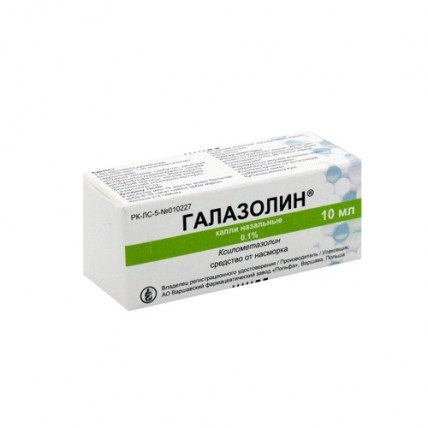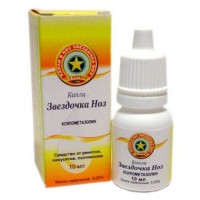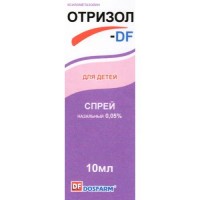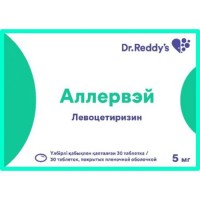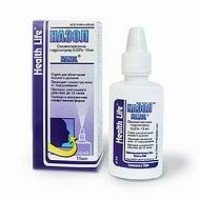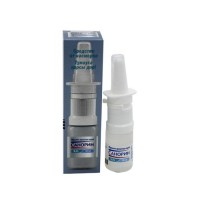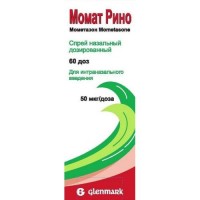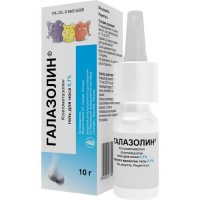GALAZOLIN® (Xylometazoline) 0.1%, 10 ml Nasal Drops
- $3.70
Compound
1 ml of solution contains active ingredients - Xylometazoline hydrochloride 0.5 mg and 1 mg,
Excipients: sorbitol, sodium hydrogen phosphate dodecahydrate, sodium dihydrogen phosphate monohydrate, disodium edetate, sodium chloride, benzalkonium chloride solution 50%, purified water.
Pharmacological properties
Pharmacokinetics
The onset of action of xylometazoline occurs within 5-10 minutes and lasts for 10 hours.
When applied to the nasal mucosa, the drug causes local vasoconstriction. Usually not absorbed in clinically significant amounts and does not have a systemic effect.
Pharmacodynamics
Xylometazoline is an imidazole derivative with a sympathomimetic effect.
Directly stimulates α-adrenergic receptors.
When applied to the mucous membrane, the drug causes vasoconstriction, eliminates swelling and hyperemia of the nasopharyngeal mucosa, and reduces the amount of secretion.
Indications for use
In complex therapy with
- Acute rhinitis (runny nose) of viral or bacterial origin
- Acute or chronic, recurrent inflammation of the paranasal sinuses
- Allergic rhinitis
- Acute inflammation of the middle ear - in order to restore the patency of the auditory tube
Dosage and administration
Intranasal application.
For hygiene reasons, one package should be intended for only one patient.
Galazolin® 0.05% nasal drops
1 drop contains 0.025 mg xylometazoline hydrochloride.
0.05% nose drops for children aged 2 to 12 years:
1-2 drops in each nasal passage, 1 or 2 times a day, every 8-10 hours.
Do not apply more than 3 times a day, in each nasal passage.
The course of treatment should not exceed 3-5 days.
Galazolin® 0.1% nasal drops
1 drop contains 0.05 mg xylometazoline hydrochloride.
0.1% nasal drops for adults and children over 12 years of age:
2-3 drops in each nasal passage, every 8-10 hours.
Do not apply more than 3 times a day, in each nasal passage.
The course of treatment should not exceed 3-5 days.
Side effects
Rarely
- irritation and dryness of the mucous membrane of the nasopharynx, burning in the nose and throat, sneezing
- allergic reactions (shortness of breath, Quincke's edema)
Very rare systemic reactions
- nausea, headache, weakness, fatigue, drowsiness
- blurred vision
- palpitations, increased blood pressure (especially in people with diseases of the cardiovascular system)
Often
- with frequent or prolonged use, irritation or dryness of the nasal mucosa, atrophy of the nasal mucosa is possible.
Contraindications
- hypersensitivity to the components of the drug
- angle-closure glaucoma
- atrophic rhinitis
- surgical interventions on the meninges
- children's age up to 2 years (for 0.05%)
- children's age up to 12 years (for 0.1%)
Drug Interactions
When combined with tricyclic antidepressants and MAO inhibitors, it can lead to an increase in blood pressure. You should not take the drug during treatment with these drugs.
Simultaneous use of xylometazoline with other sympathomimetics (eg, ephedrine, pseudoephedrine) should be avoided due to the cumulative effect.
Special instructions
Galazolin® 0.05% drops should not be given to children under 2 years of age.
Small children may become agitated or have difficulty falling asleep. If these symptoms occur, the drug should be discontinued.
Do not use the drug in patients with chronic or vasomotor rhinitis, as they tend to use the drug for more than 5 days. Prolonged use of the drug may lead to secondary vasodilation and subsequently to iatrogenic rhinitis (rhinitis medicamentosa). The cause of this disease, most likely, is the inhibition of the release of norepinephrine from nerve endings through the excitation of presynaptic α2 receptors.
Use with caution in patients with arterial hypertension, angina pectoris and other diseases of the cardiovascular system, diabetes mellitus, prostatic hyperplasia, hyperthyroidism, atherosclerosis, tachycardia.
Recommended doses should not be exceeded, especially in children and the elderly.
Due to the content of benzalkonium chloride, the drug may cause irritation of the mucous membrane of the nasopharynx.
Pregnancy and lactation
The drug should not be used during pregnancy.
There are no data regarding the excretion of xylometazoline in breast milk.
The use of the drug in breastfeeding women requires caution.
Features of influence on the ability to drive a vehicle and potentially dangerous mechanisms
The drug does not affect the ability to drive vehicles and maintain moving mechanisms if it is used in recommended doses and for a short time.
With prolonged use or at high doses, side effects from the cardiovascular system and the central nervous system may occur.
Overdose
An overdose in children, confirmed in rare cases, is characterized by symptoms such as increased and irregular heart rate, increased blood pressure, drowsiness, respiratory depression or irregular breathing, impaired consciousness. Symptomatic treatment is recommended.
Storage conditions
Store at a temperature not exceeding 25°C, protected from light.
Keep out of the reach of children!
Shelf life - 4 years
The shelf life after the first opening of the vial is 12 weeks.
Do not use after the expiration date.
